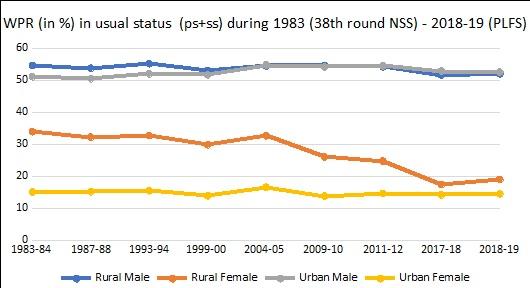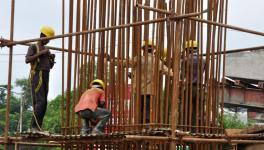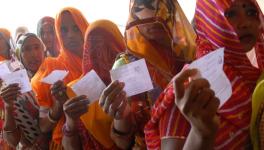Stark Reality of Women’s Employment in India: Insights from the Periodic Labour Force Survey

Representational image. | Image Courtesy: Financial Express
The Government of India (GoI) officially discontinued the quinquennial Employment and Unemployment Surveys (EUS) of National Sample Survey (NSS) 2011-12. Considering the importance of the frequent availability of labour force data, the GoI launched the annual labour force statistics under a new series, called the Periodic Labour Force Survey (PLFS), from 2017. On June 4, 2020, the GoI released the second batch of PLFS data from the survey conducted by the National Statistical Office (NSO) from July 2018 to June 2019, which covered 4.2 lakh people across 1.01 lakh households in India.
It is to be noted that although the annual PLFS provides high-frequency data on broad employment-unemployment related indicators, the comparability between the PLFS and the previous NSS-EUS has always been debated. To avoid this and to ensure as much comparability as possible, only data from the first visit is used here (urban households in the survey were visited four times by PLFS enumerators, and data from their revisits has not been considered in this analysis).
According to the PLFS (2017-18), the Workforce Participation Rate (WPR) for women was 16.5% at the all India level, which is reported to have increased to 17.6% in 2018-19, as per the recently released PLFS (2018-19). The increase in the overall women’s WPR is largely driven by the increase in rural women’s WPR, as that has increased from 17.5% to 19% between 2017-18 and 2018-19. Importantly, after 2004-05, this is the first time when the WPR for rural women has increased; however it is still much lower than the number for 2011-12 (women WPR was 25% in 2011-12). Also, it is noted that there is a wide divergence in women WPR across rural and urban areas, and this has always remained low in urban areas. Moreover, over the period 2017-18 and 2018-19, there has been no significant change in the WPR for urban women.

Source: Calculated from NSS-EUS and PLFS data
A closer look at the employment types indicates that the rise in rural women’s WPR can be largely explained by an increase in self-employment for the same period (2017-18 to 2018-19). Self-employment is the main source of employment for rural women who are largely employed as unpaid family helpers that help household members in running their enterprise, but do not receive any regular wage or salary in return. However, over the period 2017-18 and 2018-19, there has been a significant increase (by 3 percentage points) in the proportion of Own Account Employment (OAE) (i.e. employment without any hired worker) among rural women.
A further look into the own-account employment across industries, reveals an increase in the share of women’s employment in the manufacturing industry in rural areas over the period 2017-18 and 2018-19. The major contributors to women's own-account manufacturing employment are textile and food processing industries, which were largely dominated by small scale units. Within the textile industry, rural women performed various kinds of activities like zari, stitching laces, and other activities related to handloom work. The demand for women workers has continuously increased over time since they provide cheap and flexible labour which is also easily available. In industries which manufacture food products, women are largely involved with products like bakery items, confectioneries, sugar and grain mill products like flour, rice, milling pulses and the like.
Of those surveyed, 97% of the women operate in enterprises with less than six workers, in 2018-19. Further, 81% of these women-owned enterprises are operated from within their household premises. As per the sixth Economic Census, most of them even lack basic facilities like toilets, waste management facilities and the availability of banks or post offices. It not only implies their limited scope of employment generation and capacity, but also indicates that they are more likely to be entrepreneurs driven by necessity. So, a further rise in women’s own account employment, raises many questions about the aim and scope of rural women entrepreneurship in India, and indicates that the extent of opportunity-oriented entrepreneurship is very low among rural women.
Meanwhile, the unemployment rate in 2018-19 was pretty high as compared to 2011-12, and it is further higher in urban areas as compared to rural areas. Additionally, the unemployment rate was the highest for urban women over all the periods when compared to their rural counterparts, but between 2017-18 and 2018-19, a marginal decline was noticed. It is also disheartening to note that the more educated young women are the least likely to be employed — and more likely to be openly unemployed — such that though the unemployment rate for young women in urban areas was 12% in 2018-19, for young urban educated women (those who have attained the secondary and above level of education), it went up to as high as 18%, during the same period. Thus, higher education does not seem to guarantee employment for many young women and it indicates the persistent problem of a lack of jobs for the educated youth, a trend which continues in 2018-19 as well.
Over the same period, a significant change was also observed among the status of employed persons, both in rural and urban areas. In rural areas, there has been a significant increase in self-employment among men, along with a consistent decline in causal wage labourers, over the period between 2011-12 and 2018-19. Between 2017-18 and 2018-19, despite a marginal decline, self-employment is the major source of livelihood for rural men. Over the entire period (2011-12 to 2018-19), regular wage employment was the predominant source of employment for both men and women in urban areas. However, a significant change was observed among the urban employed persons in India, as regular wage employment increased sharply, along with a decline in casual employment for both men and women. From 2011-12 to 2018-19, an increase in regular wage employment was more prominent for women as compared to men, but it would have been a positive change if urban women’s WPR had also increased over the same period. However, no such increased was witnessed, suggesting that there has barely been any increase in the absolute numbers of urban women’s employment in regular, salaried jobs.
Unlike the EUS of NSSO, which collects wages data for regular salaried and casual wage labourers, the PLFS collects information on earnings from self-employment as well. Not surprisingly, all the unit-level data of the labour force surveys (both NSS-EUS and PLFS) suggest that the average daily wages and earnings were higher in urban areas than in rural areas, and the same was seen for regular employees as compared to casual labourers. Similarly, average daily wage rates were higher for men across all the categories of workers over the entire period, 2011-12 to 2018-19. In terms of gender wage gaps, the ratio of wages and earnings of women workers, to that of male workers, was indicative of the higher gender earning gap for self-employed workers in both rural and urban areas, relative to women regular employees and casual labourers in both the periods, 2017-18 and 2018-19. However, the gender wage gaps for self-employed workers had further increased in urban areas over 2017-18 and 2018-19, and urban women received 62% lower earnings as compared to men, in 2018-19. On the other hand, the gender wage gap has declined for regular salaried employees in both rural and urban areas between 2011-12 to 2018-19. However, in private casual work, gender wage gaps have increased for the same period in both areas.
The analysis suggests that women are the worst casualties of the labour market crisis in India, and evidence also suggests that since they cannot afford to be unemployed, it forced them to take whatever employment was available. It also highlights the plight of women own-account workers in India, as they not only have a limited scope of employment generation, but also faced larger gender wage discrimination as compared to other types of workers. This reveals that various schemes and interventions of the Central Government, like skill development programmes and credit access through MUDRA loans to promote women employment, is not sufficient on its own. Providing basic infrastructure facilities to women workers is of utmost necessity along with the above interventions, in order to improve their working conditions. All this might not only lead to better employment opportunities but also open gainful employment avenues for women in the country.
The writers are economists based in New Delhi and Bengaluru, respectively. The views are personal.
Get the latest reports & analysis with people's perspective on Protests, movements & deep analytical videos, discussions of the current affairs in your Telegram app. Subscribe to NewsClick's Telegram channel & get Real-Time updates on stories, as they get published on our website.
























